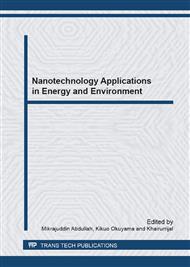[1]
J. Shewchun, R. Singh, M. A. Green, Theory of metal-insulator-semiconductor solar cells, J. Appl. Phys. 48 (1977) 765-770.
DOI: 10.1063/1.323667
Google Scholar
[2]
H. C. Card, Photovoltaic properties of MIS-Schottky barriers, Solid-State Electron 20 (1977) 971-976.
DOI: 10.1016/0038-1101(77)90206-4
Google Scholar
[3]
L. Li, H. Xiang, Preparation and research on TiO2/SiO2 nanofilm with high transmittance on solar cell glass, Mater. Sci. Forum 610 (2009) 382-388.
DOI: 10.4028/www.scientific.net/msf.610-613.382
Google Scholar
[4]
C. G. Granqvist, A. Hultaker, Transparent and conducting ITO films: new developments and applications, Thin Solid Films 411 (2002) 1-5.
DOI: 10.1016/s0040-6090(02)00163-3
Google Scholar
[5]
Y. –H. Hu, H. –J. Xu, H. Gao, Y. –C. Chen, fabrication the texture zinc oxide thin films and its application in hydrogenated amorphous silicon solar cell, Mater. Sci. Forum 663 (2011) 1077-1080.
DOI: 10.4028/www.scientific.net/msf.663-665.1077
Google Scholar
[6]
D. Hocine, M. S. Belkaïd, K. Lagha, Influence of interfacial oxide layer thickness on conversion efficiency of SnO2/SiO2/Si(N) solar cells, Revue des Energies Renouvelables 11 (2008) 379-384.
DOI: 10.24084/repqj06.255
Google Scholar
[7]
C. Kilic, A. Zunger, Origins of coexistence of conductivity and transparency in SnO2, Phys. Rev. Lett. 88 (2002) 095501-1/4.
Google Scholar
[8]
Y. Matsui, Y. Yamamoto, S. Takeda, Stability in electrical properties of ultra thin oxide films, Mat. Res. Sym. Proc. 621 (2000) 491-496.
DOI: 10.1557/proc-621-q4.9.1
Google Scholar
[9]
Y. Mi, H. Okada, S. Iwata, Electronic structures and optical properties of ZnO, SnO2, and In2O3, Jpn. J. Appl. Phys. 38 (1999) 3453-3457.
Google Scholar
[10]
M.-M. Bagheri-Mohagheghi, M. Shokooh-Saremi, The influence of Al doping on the electrical, optical and structural properties of SnO2 transparent conducting films deposited by the spray pyrolysis technique, J. Phys. D: Appl. Phys. 37 (2004) 1248-1253.
DOI: 10.1088/0022-3727/37/8/014
Google Scholar
[11]
R. Gordon, Criteria for choosing transparent conductors, MRS Bull. 25 (2000) 52-57.
DOI: 10.1557/mrs2000.151
Google Scholar
[12]
H. –W. Ryu, Y. –J. Park, H. –S. Noh, J. –S. Park, Characteristics of SnO2 thin films deposited by RF magnetron sputtering, Mater. Sci. Forum 449 (2004) 993-996.
DOI: 10.4028/www.scientific.net/msf.449-452.993
Google Scholar
[13]
W. W. Wenas, S. Riyadi, Carrier transport in high-efficiency ZnO/SiO2/Si solar cells, Sol. Energy Mater. Sol. Cells 90 (2006) 3261-3267.
DOI: 10.1016/j.solmat.2006.06.026
Google Scholar
[14]
F. Bouzid, S. Ben Machich, The effect of solar spectral irradiance and temperature on the electrical characteristics of a ZnO-SiO2-Si (N) photovoltaic structure, Revue des Energies Renouvelables 13 (2010) 283-294.
Google Scholar
[15]
A. B. Suryamas, Electron spin polarization in semiconductor heterostructure with single and double barriers, Thesis Magister, Institut Teknologi Bandung, Indonesia, 2007. (in Indonesian)
Google Scholar
[16]
F. A. Noor, M. Abdullah, Sukirno, Khairurrijal, Comparison of electron transmittances and tunneling currents in an anisotropic TiNx/HfO2/SiO2/p-Si(100) metal oxide–semiconductor (MOS) capacitor calculated using exponential- and Airy wavefunction approaches and a transfer matrix method, J. Semicond. 31 (2010) 13402-1/5.
DOI: 10.1088/1674-4926/31/12/124002
Google Scholar
[17]
S. M. Sze, K. K. Ng, Physics of Semiconductor Devices, 3rd Edition, John Wiley & Sons, New Jersey, 2007.
Google Scholar
[18]
W. Xie, L. Zhang, S. Liu, Modification of the electrodes of organic light-emitting devices using the SnO2 ultrathin layer, Semicond. Sci. Technol. 19 (2004) 380-383.
DOI: 10.1088/0268-1242/19/3/014
Google Scholar
[19]
J. Shewchun, J. Dubow, A. Myszkowski, R. Singh, R, The Operation of the Semiconductor-Insulator-Semiconductor (SIS) Solar Cells: Theory, J. Appl. Phys. 49 (1978) 855-864.
DOI: 10.1063/1.324616
Google Scholar
[20]
Khairurrijal, W. Mizubayashi, S. Miyazaki, M. Hirose, Analytic model of direct tunnel current through ultrathin gate oxides, J. Appl. Phys. 87 (2000) 3000-1/5.
DOI: 10.1063/1.372290
Google Scholar
[21]
J. F. Wager, Transparent electronics: Schottky barrier and heterojunction considerations, Thin Solid Films 516 (2008) 1755–1764.
DOI: 10.1016/j.tsf.2007.06.164
Google Scholar
[22]
E. J. H. Lee, C. Ribeiro, T. R. Giraldi, E. Longo, E. R. Leitea, J. A. Varela, Photoluminescence in quantum-confined SnO2 nanocrystals: evidence of free exciton decay, Appl. Phys. Lett. 84 (2004) 1745-1747.
DOI: 10.1063/1.1655693
Google Scholar
[23]
A. H. M. Shousha, Performance characteristics of thin film MIS solar cells, Sol. Wind Technol. 6 (1989) 705-712.
DOI: 10.1016/0741-983x(89)90008-8
Google Scholar
[24]
N. R. Saha, D. Roychoudhury, P. K. Basu, Analytical study of the performance of minSIS solar cells with a back surface field, Appl. Phys. A 32 (1983) 187-193.
DOI: 10.1007/bf00820259
Google Scholar



